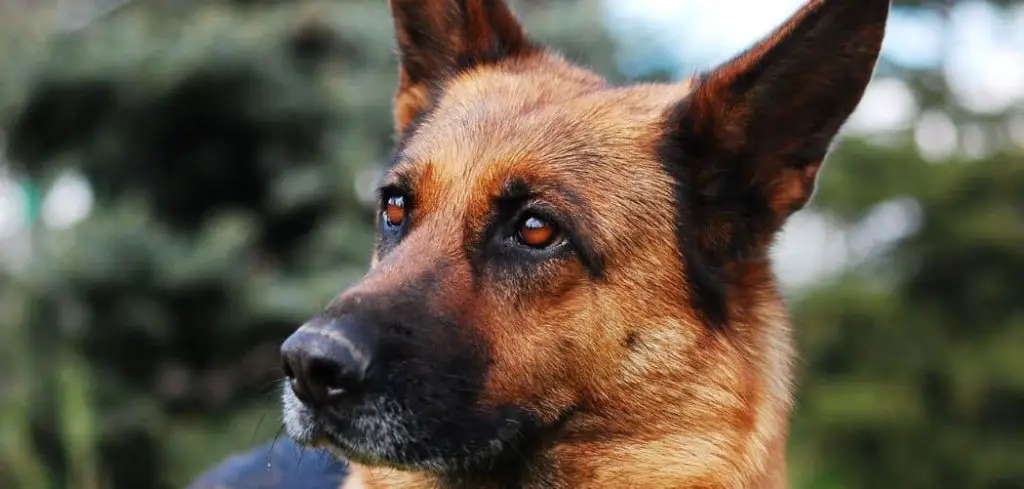If your dog has diarrhea and bad breath at the same time, you might be wondering what’s going on and whether it’s a sign of something serious.
We outline the causes of dog diarrhea and bad breath, what they might indicate about your dog’s health, and when it’s time to seek veterinary help.
Table of Contents
Here’s Why Dog Diarrhea and Losing Hair Happens
Dog diarrhea and bad breath occurring together may indicate underlying gastrointestinal issues, dental disease, or systemic illness.
Diarrhea often results from infections, dietary indiscretion, or parasites, while bad breath (halitosis) is commonly linked to dental problems like tartar buildup or gum disease.
However, when both symptoms appear simultaneously, it may suggest that toxins or infections are affecting both the digestive tract and the mouth, or that liver or kidney dysfunction is at play—both of which can cause foul breath and loose stool.

Common Signs of Dog Diarrhea and Bad Breath
Some symptoms to watch for when your dog is experiencing both conditions include:
Loose, frequent, or foul-smelling stools
Persistent or sudden foul odor from the mouth
Lethargy or lack of energy
Drooling or pawing at the mouth
Decreased appetite
Vomiting
Signs of discomfort or pain
Weight loss
These combined symptoms should never be ignored, especially if they last more than 24–48 hours.
Causes of Dog Diarrhea and Bad Breath
Several conditions can lead to your dog developing both diarrhea and bad breath.
Common causes include:
1. Dental Disease
One of the leading causes of bad breath in dogs is dental disease, including plaque buildup, gingivitis, or periodontitis. Bacteria from poor oral hygiene not only cause halitosis but can also enter the bloodstream and affect other parts of the body, including the gastrointestinal tract.
This systemic spread of bacteria can trigger gastrointestinal disturbances, resulting in dog diarrhea. Dogs with advanced dental disease may also struggle with chewing food properly, leading to digestive upset and irregular stools.
Signs of dental disease include:
Red, swollen gums
Bleeding during chewing
Loose or missing teeth
Refusal to eat hard food
Yellow or brown buildup on teeth
Regular dental care and professional cleanings can reduce the risk of both dog bad breath and diarrhea caused by oral bacteria.
Related: Dog diarrhea and losing weight (Explained)
2. Gastrointestinal Infections
Infections caused by bacteria, viruses, or parasites can affect your dog’s digestive tract and lead to both diarrhea and bad breath.
Examples of common gastrointestinal infections include:
Salmonella
Giardia
Parvovirus
Campylobacter
These infections often produce toxins in the gut, which can lead to foul-smelling breath and other symptoms like vomiting, diarrhea, and dehydration. Some bacterial infections may cause sulfur-like odors from the mouth, a symptom closely linked with the presence of harmful pathogens.
3. Diet and Dietary Indiscretion
Dogs that eat things they shouldn’t—like garbage, spoiled food, or unfamiliar treats—can develop both bad breath and diarrhea.
Dietary indiscretion can lead to bacterial overgrowth in the gut or irritate the digestive lining, leading to dog diarrhea. At the same time, the consumption of rotten or decomposing food can cause your dog’s breath to smell foul.
Switching dog food too quickly can also upset the balance of good bacteria in the gut, causing loose stools and strange breath odors.
Prevent this by:
Avoiding sudden diet changes
Keeping garbage and toxins out of reach
Feeding only dog-approved treats and food
Related: Dog diarrhea and leg pain (Explained)
4. Liver or Kidney Disease
Bad breath in dogs that smells like ammonia or rotten meat can be a sign of kidney disease, while a musty or sweet smell could point toward liver problems. Both of these internal diseases can also trigger diarrhea in dogs due to the organs’ inability to properly process and eliminate toxins.
In dogs with kidney or liver issues, waste products build up in the blood, leading to halitosis and gastrointestinal distress.
Additional symptoms may include:
Increased drinking or urination
Vomiting
Yellowish eyes or gums
Abdominal pain
Loss of appetite
If your dog has persistent bad breath and diarrhea, especially with these other symptoms, consult your vet for bloodwork and a health evaluation.
5. Pancreatitis
Pancreatitis, or inflammation of the pancreas, can cause both bad breath and diarrhea in dogs. This condition is often triggered by a high-fat meal, obesity, or certain medications.
Dogs with pancreatitis often have foul-smelling stools, bad breath from digestive imbalances, and signs of abdominal pain.
Other signs include:
Vomiting
Fever
Hunched posture
Lethargy
Prompt veterinary care is essential, as untreated pancreatitis can lead to serious complications.
Related: Dog diarrhea and sore throat (Explained)
6. Foreign Object Ingestion
When a dog swallows a foreign object like a toy, sock, or bone fragment, it can cause blockages or irritation in the gastrointestinal tract. This often leads to diarrhea, vomiting, and bad breath due to reduced digestion and bacterial buildup.
If the object gets lodged in the mouth or throat, it may also cause localized infections that lead to halitosis.
Seek immediate veterinary attention if your dog shows:
Repeated gagging or coughing
Bloated abdomen
Lack of bowel movement
Signs of pain or discomfort
7. Diabetes
Canine diabetes can lead to bad breath that smells fruity or sweet, caused by a buildup of ketones in the blood (a condition called ketoacidosis). Dogs with diabetes may also develop diarrhea due to poor nutrient absorption and imbalanced blood sugar levels.
Watch for these other diabetes symptoms:
Increased thirst and urination
Weight loss despite eating
Lethargy
Cloudy eyes (cataracts)
Diabetes is a chronic condition that requires medical management, so early diagnosis is critical.
Dog Diarrhea and Bad Breath: What to Do and When to See a Vet
If your dog is dealing with both diarrhea and bad breath, here’s what you should do:
Step 1: Monitor Symptoms
Keep track of how long the symptoms last, their severity, and any other changes in behavior, appetite, or bathroom habits.
Step 2: Hydration and Bland Diet
Ensure your dog stays hydrated. Mild diarrhea can be managed at home by feeding a bland diet like boiled chicken and rice for a couple of days.
Avoid giving treats, table scraps, or changing foods abruptly.
Step 3: Practice Oral Hygiene
Brush your dog’s teeth regularly using dog-specific toothpaste. Dental chews and professional cleanings can also help reduce bad breath and improve oral health.
Step 4: Visit the Vet if Symptoms Persist
You should contact your vet immediately if:
Diarrhea lasts more than 2 days
There’s blood or mucus in the stool
Bad breath smells especially foul or sweet
Your dog is vomiting or lethargic
There are signs of dehydration or pain
Your dog is a puppy or senior with a compromised immune system
Key Takeaway: Why Dog Diarrhea and Bad Breath Happens
While dog diarrhea and bad breath might seem unrelated, they often share a common root cause. Whether it’s dental disease, infections, diet, or internal illness, these symptoms can signal that something is wrong.
Don’t ignore persistent bad breath or chronic diarrhea in dogs, especially when they appear together. Identifying the cause early can prevent complications and ensure your dog stays happy and healthy.
By taking a proactive approach—focusing on oral hygiene, proper diet, regular vet checkups, and monitoring your dog’s overall wellness—you can help reduce the risk of your dog developing diarrhea and bad breath at the same time.
